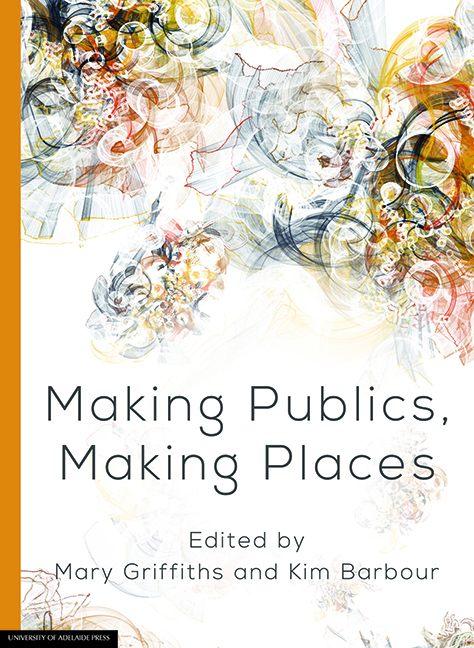Book contents
- Frontmatter
- Contents
- Preface
- Abstracts
- List of contributors
- 1 Making publics, making places
- 2 The elasticity of the public sphere: Expansion, contraction and ‘other’ media
- 3 ‘Imagine if our cities talked to us’: Questions about the making of ‘responsive’ places and urban publics
- 4 Picturing placelessness: Online graphic narratives and Australia's refugee detention centres
- 5 Reclaiming heritage for UNESCO: Discursive practices and community building in northern Italy
- 6 Find your Adelaide: Digital placemaking with Adelaide City Explorer
- 7 Chinese films and the sense of place: Beijing as ‘Thirdspace’ from In the Heat of the Sun to Mr Six
- 8 Social media and news media: Building new publics or fragmenting audiences?
- 9 The use of Chinese social media by foreign embassies: How ‘generative technologies’ are offering opportunities for modern diplomacy
- 10 An opinion leader and the making of a city on China's Sina Weibo
- 11 Public audiencing: Using Twitter to study audience engagement with characters and actors
- 12 Overcoming the tyranny of distance? High speed broadband and the significance of place
12 - Overcoming the tyranny of distance? High speed broadband and the significance of place
Published online by Cambridge University Press: 28 July 2017
- Frontmatter
- Contents
- Preface
- Abstracts
- List of contributors
- 1 Making publics, making places
- 2 The elasticity of the public sphere: Expansion, contraction and ‘other’ media
- 3 ‘Imagine if our cities talked to us’: Questions about the making of ‘responsive’ places and urban publics
- 4 Picturing placelessness: Online graphic narratives and Australia's refugee detention centres
- 5 Reclaiming heritage for UNESCO: Discursive practices and community building in northern Italy
- 6 Find your Adelaide: Digital placemaking with Adelaide City Explorer
- 7 Chinese films and the sense of place: Beijing as ‘Thirdspace’ from In the Heat of the Sun to Mr Six
- 8 Social media and news media: Building new publics or fragmenting audiences?
- 9 The use of Chinese social media by foreign embassies: How ‘generative technologies’ are offering opportunities for modern diplomacy
- 10 An opinion leader and the making of a city on China's Sina Weibo
- 11 Public audiencing: Using Twitter to study audience engagement with characters and actors
- 12 Overcoming the tyranny of distance? High speed broadband and the significance of place
Summary
Introduction
In 2009, the Australian federal government decided to fund the construction of the National Broadband Network, or NBN. At a total projected cost of A$44 billion, it was the largest engineering and public infrastructure project in Australia's history, with the intention of laying 200 000 km of fibre optic cable to the doors of 93 per cent of Australian premises. For the remaining 7 per cent of people, who lived in rural and remote areas, wireless and satellite would replace fibre. However, in 2013, this fibre-tothe- premises [FttP] model was subsequently replaced by a much slower, hybrid model that used a mix of optic-fibre, co-axial cable and copper infrastructures alongside wireless and satellite in regional and remote areas (see Arnold et al. 2014 for installation history).
One of the stated key goals of the various plans for high speed broadband networks in Australia is to overcome the challenges of distance and the concomitant difficulties for transport implicit in distance. For example, in the initial scheme, the then Minister for Broadband, Communications and the Digital Economy, Stephen Conroy, signalled broadband-enabled benefits relating to social inclusion, economic productivity and geographic connectivity. He stated that ‘every person and business in Australia, nomatter [sic] where they are located, will have access to affordable, fast broadband at their fingertips’, and that high speed broadband [HSB] ‘will help drive Australia's productivity, improve education and health service delivery and connect our big cities and regional centres’ (2009). Australian geography has had a major impact on the history of telecommunications in the nation (see, for example, Given 2010). The National Broadband Network [NBN] has been promoted as a way of overcoming the ‘tyranny of distance’ experienced by people in remote and rural regions (Swan & Conroy 2011).
In this chapter, we seek to examine the dynamics of this process, exploring what high speed broadband infrastructure means for overcoming (or ameliorating the effects of) the ‘tyranny of distance’ for those living in regional and remote areas, and what HSB means for the social and material significance of these places.
- Type
- Chapter
- Information
- Making Publics, Making Places , pp. 193 - 216Publisher: The University of Adelaide PressPrint publication year: 2016



